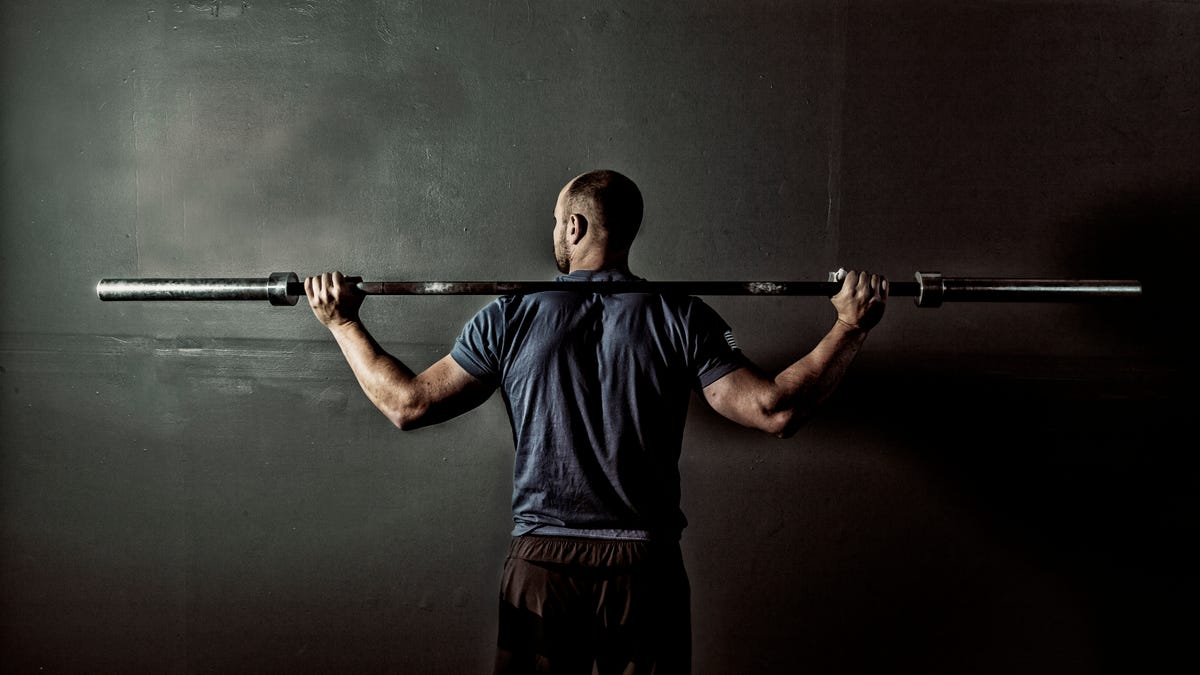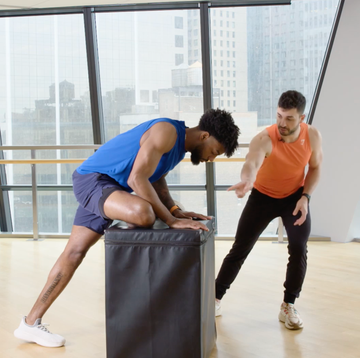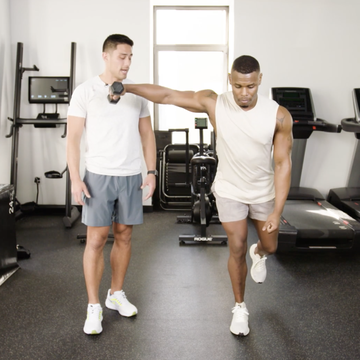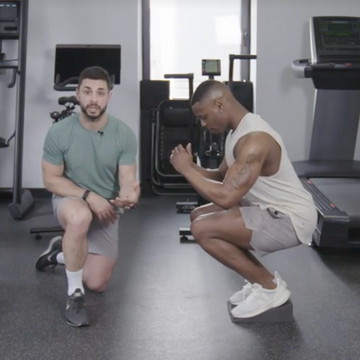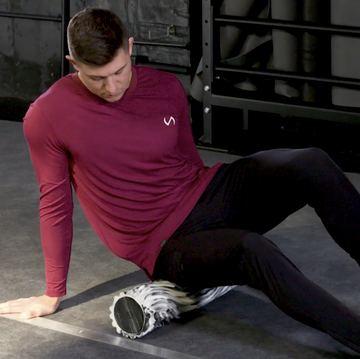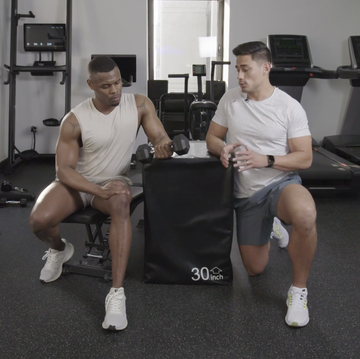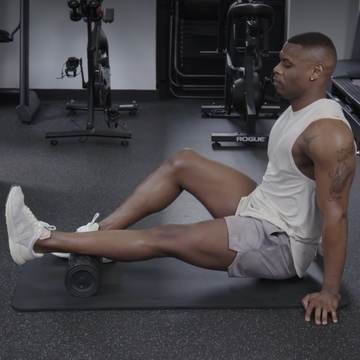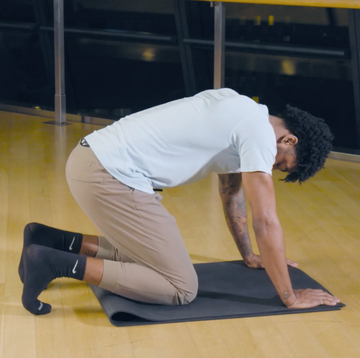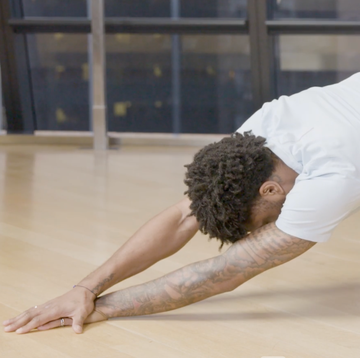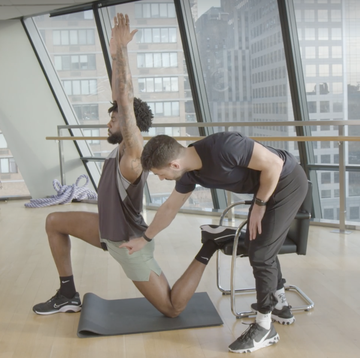IF YOU'VE EVER felt a pinch of pain in the shoulder when you reach for something above your head, you know how vital proper function of the joint is for your everyday life. Once you hit the gym, proper shoulder function is even more important. The muscle group is a major mover in big upper body lifts like the overhead press, tricep extensions, and rows.
But nagging pain and popping in the shoulder can put a damper on your lifts (and your life). These malfunctions are often caused by issues with the rotator cuff. Philip Tam, PT, DPT, of Bespoke Treatments takes us through four exercises that are great for strengthening and stabilizing your rotator cuff.
What Is the Rotator Cuff?
The rotator cuff is made up of four muscles: the infraspinatus, the subscapularis, the supraspinatus, and the teres minor. The shoulder is a ball and socket joint, meaning the arm bone form a ball that glides around inside of the concave portion of the shoulder blade. These four muscles are known as the "cuff" because they create a hood around the ball portion, acting as catalysts for a wide range of movement.
What Does the Rotator Cuff Do?
The subscapularis sits on the front side of your shoulder blade, the supraspinatus sits on top, and the infraspinatus and teres minor both sit on the back. With the shoulder blade covered on all sides, the rotator cuff muscles rotate the shoulder, as well as abduct, which helps pull the arm away from the body. These muscles are the reason you can open a door or throw a football.
Together, they are also responsible for stabilizing the joint. You can thank them for your shoulder not popping out of place when holding a plank or throwing a fastball. Because these muscles are constantly in use, they can become painful if not properly trained. If you're feeling achey in any portion of your shoulder, or if you're heading some irregular popping or clicking sounds, your rotator cuffs may be in need of some love.
Give these four exercises a try when your shoulder is feeling weak or painful.
4 Exercises to Strengthen And Stabilize The Rotator Cuff
Side-Lying External Rotation
Try this move to warm up for your next chest day. Strengthening the muscles that are used for external rotation will be beneficial to help stabilize the shoulder, especially for movements like bench presses. It may also help alleviate pain that you may be feeling on the front of the shoulder by releasing some of the load.
You're going to want to start a tiny weight for this one. Think 2 or 3 pound dumbbell. (No, no one will judge you for picking up the small weights.)
How to Do It:
- Start on your side, with the upper arm tucked into the rib cage
- Bend the elbow to 90 degrees, holding the dumbbell.
- Rotate by lifting the wrist up towards the ceiling, without allowing the elbow to slide back off the ribcage.
- Only rotate to where is comfortable.
- Start with 10 to 12 reps with a very low weight. If you get to 10 and it feels okay, feel free to go up no more than a pound. Small increment increases make a big difference with tiny muscles like these.
Side-Lying Horizontal Abduction
This exercise lights up the posterior side of your rotator cuff. Use it to warm up for your next back day, or any exercise where your arm goes into extension, like bent-over rows.
Be ready with a yoga block or balled-up towel and that extra light dumbbell for this one.
How to Do It:
- Start by on your side, placing the towel or yoga block under the head to keep the neck neutral.
- Keep both arms straight out in front of you with a soft bend in the elbow— just enough to keep the joint from locking out.
- Hold the dumbbell in your top hand.
- Rotate by lifting the wrist up towards the ceiling, without going past your body.
- Slowly lower back towards the floor.
- Aim for 10 to 12 reps for 3 sets on each side.
The Swimmer's Exercise
We dare you to use this as a finisher to your next shoulder-heavy training day. You'll incorporate every motion of the rotator cuff, and gives the back and core a little extra challenge too.
How To Do It:
- Lie flat on the stomach, with the neck relaxed.
- Start with your palms on the back of your head, and squeeze the shoulder blades together to lift the elbows off the floor.
- Rotate the arms back and down, pronating the palms to face the ceiling by the time they reach the hips.
- Maintain tension at the shoulder blades as you bring the arms back up towards the head.
- Aim for 8 to 10 reps for 3 sets.
Banded Scaptions
This move uses resistance to hit all four rotator cuff muscles, which can aid in improving the stability of the shoulder. This is another great move to incorporate into your shoulder day.
In this example, we're anchoring the band with the feet, but can also do this move by anchoring with a chair or a bench.
How To Do It:
- Anchor the band. If you're using your feet, start with them close together. (When you're ready, you can separate them out to add more resistance.)
- Lift the arms at a 45 degree angle out to the side, pointing the thumbs up towards the ceiling.
- Only lift to eye-level.
- Find a resistance that's easy enough that your shoulders don't try to struggle up to your ears.
- Aim for 8 to 12 reps for 3 sets.
Take all these moves slow and steady, only moving with a comfortable range of motion. Start with light weights— it doesn't take much to wear out these small muscles. If you feel like you want to go up in resistance, do so gradually. If anything causes more pain, call your physical therapist or physician to get it checked out.
Cori Ritchey, NASM-CPT is an Associate Health & Fitness Editor at Men's Health and a certified personal trainer and group fitness instructor. You can find more of her work in HealthCentral, Livestrong, Self, and others.
